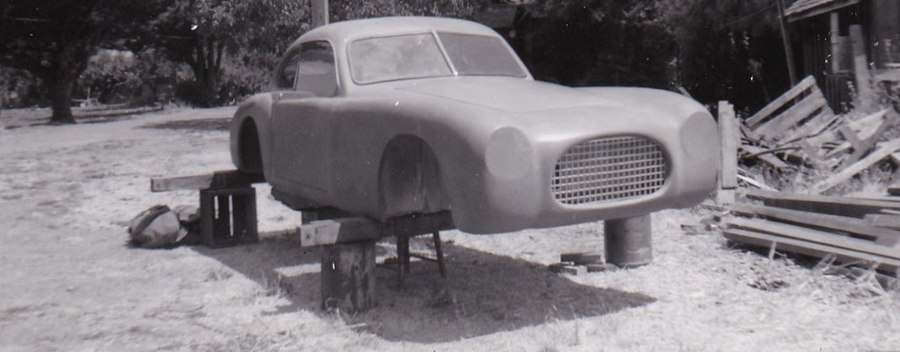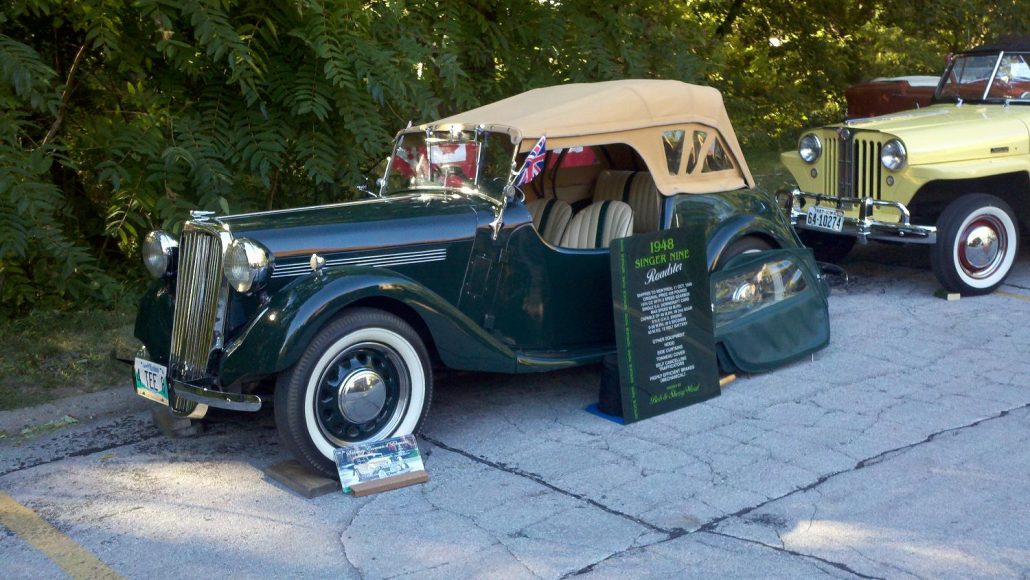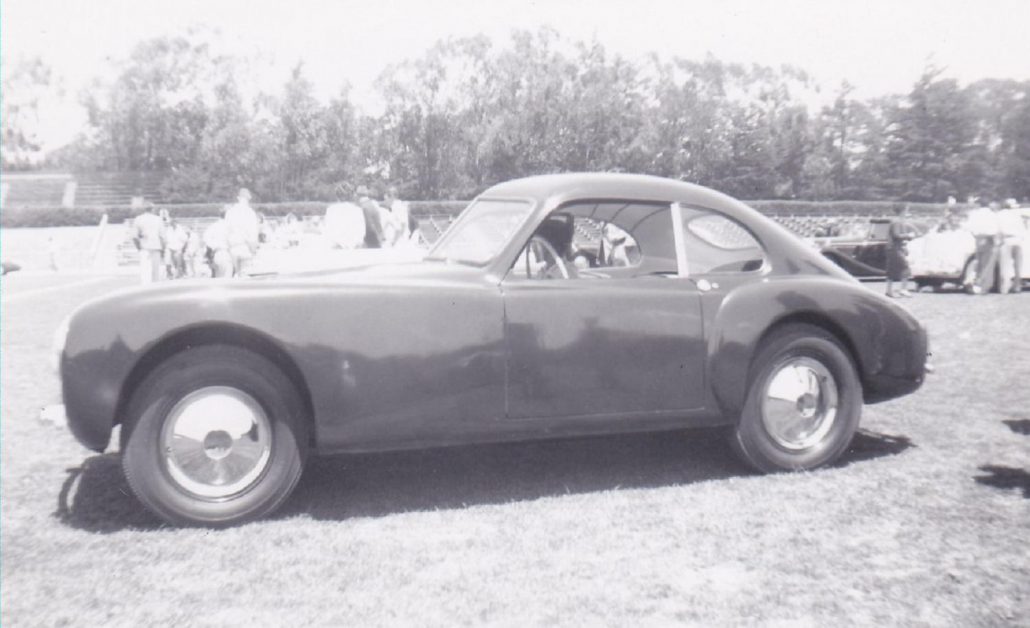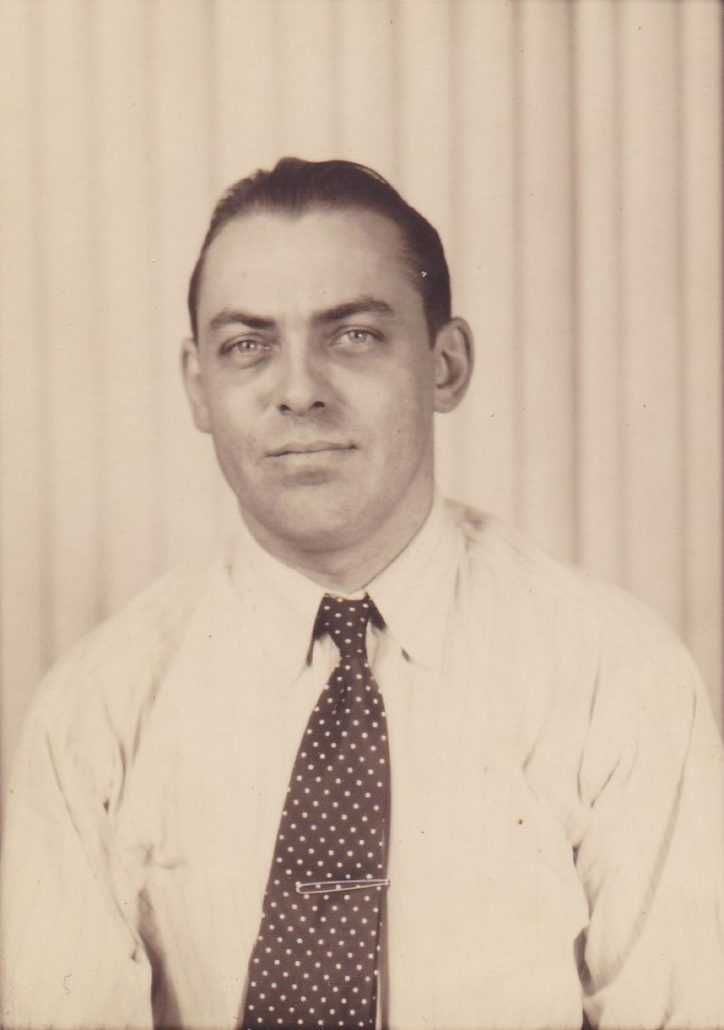
You started with a body when you bought An Allied Swallow in the 1950s. You could order a chassis too.
Hi Gang…
I finally found one! A Singer Special.
That’s what I said back in 2015 we we acquired a very nice example of a Singer Special built using a Allied Swallow body. We always call these cars “Allied Cisitalia” sports cars after the car that the original mold was taken from – a 1947 Cisitalia 202 coupe. I guess this one is an “Allied Cisitalia Singer” sports car which means that the name of the car appears to be getting longer
I’ve belonged to the Singer Owner’s Club for many years and have worked with Phillip Avis and Peter McKercher in helping document the use of Singer sports cars as part of the American racing and sports car scene in the 1950s. Click here to learn more about the North American Singer Owner’s Club. And while we usually think of the British MG sports cars used as the basis of smaller American Specials – Singers were too. Singers are just far more rare.

It’s great to see a Singer Roadster at a Concours – this one was shown at the 2012 Salisbury Concours d’Elegance in Des Moines, Iowa. Nice sports car!
A Singer was similar to an MG in styling and size but had a bit more powerful, performance oriented engine. Most people are unaware of Singers because for every 10 MG sports cars imported into the USA in the early 1950s, just one Singer sports car arrived. Singer sports cars from the early 1950s are rare indeed! We’ve written about Singer Specials built in the USA and the UK before and you can read about some of these specials via the link below:
Click Here To Read About Singer Specials in the USA and UK
Given our in-house expertise on Singers via the Singer Owner’s Club, I asked Phillip Avis if he would help with the research on the car we acquired. Phillip did and put pen to paper and got to work. Today, I’m honored to have another article to share with you, and this one is about our Singer Special. So off we go on another Undiscovered Classics research adventure and….take it away Phillip
Telling The Tale of ‘Torquie’
Originally printed in NASOC NEWS 3 – 2018
Author: Phillip Avis
Geoff Hacker, NASOC member and friend to all things fiberglass, recently uncovered a very exciting find. It’s a 1952 Singer 4AD Roadster chassis fitted with an Allied / Atlas Swallow fiberglass body and probably the only one in existence. It had been owned for over fifty years by Ronald Pierce. Ronald and his friend of many years, Don Bender, trailered the Singer from Shafter, California to Tampa, Florida – a 5,500 mile ‘round trip – to deliver the car to Geoff. Before leaving on the return journey, the boys stopped off in Lakeland Florida to pick up a restored 1946 Ercoupe aircraft for Don. Quite an adventure for them both.
So how did a 1952 Singer 4AD Roadster morph into a sleek Atlas Swallow?
Back in the early 1950’s there was a sudden blossoming of small, independent sports car designs based on the new miracle material, ‘fiberglass’. It enabled more flowing and dramatic concepts to be realised at a relatively low cost and without a need for expensive tooling. The Allied Swallow project was one of the many, but one with some serious credibility behind it and one that was more thoroughly thought out than most.
The team behind the Swallow body included Bill Burke, who built the first lakebed ‘belly tank’ racer, Micky Thompson, the speed equipment parts supplier, and Roy Kinch, who owned Allied Manufacturing, a fiberglass supplier. The inspiration for the Swallow came from the Cisitalia 202, a sports couple designed and built in Italy by the “Compagnia Industriale Sportiva Italia”, a business conglomerate founded by the wealthy industrialist Piero Dusio. Introduced in 1946, the Cisitalia 202 GT changed the direction of modern sports car design and was considered “rolling sculpure,” by the museum of Modern Art in New York.
Actually, the Cisitalia didn’t just provide the inspiration for the Swallow, it was the basis for the Swallow. If imitation is the best form of flattery, then what is it when you actually copy the form? Bill Burke, whose lakebed racing experience made him appreciate the importance of aerodynamics, was more interested in the Cisitalia’s sleek shape than its aesthetic beauty. It just so happened that Bob Peterson, the famous publisher, had a 202 and Burke discovered it in George Barris’ custom shop being prepared for a new paint job. Burke seized upon the idea to pull a mold of the body and create his own copies in fiberglass.
Once the trio had the business set up, both the coupe, probably the first production fiberglass coupe body ever, and a convertible were put into production. Although the convertible was listed, it is unknown if any were actually built. These were not the usual flimsy fiberglass shells, but well-assembled bodies with steel tube reinforcements.
The kit included the grille, headlights, taillights, mounted hood and doors, roll-up side windows, a windshield and a rear window, Optional items included the dashboard, the firewall, inner wheel arches and body mounting brackets designed to suit the donor chassis. Pricing ranged from $585.00 to $785.00 and the shells were available in a 92” to 96” wheelbase. No chassis frames were officially offered, but Allied would make them to order, if requested. Detailed records weren’t kept, but it is estimated that 25 Swallow bodies were built in all.
One man who was impressed with the Atlas Swallow was Lawrence Showalter. Lawrence had purchased a Singer Roadster that had a damaged body and felt that the Swallow body would make an excellent and far more attractive replacement. The body was duly purchased and hauled from Los Angeles, California to Showalter’s home in Petaluma, California where the project began. Ron’s purchase of the car years later had a lot to do with his family’s history with Showalter;
As Ron says, “I can remember when he purchased the Swallow body in LA because he stopped by our house in Shafter on the way back to his home in Petaluma. He had the Allied Swallow the body on the trailer,” said Ron,”He promised everybody that he would have it going in a month of Sundays and he did, but it did not have the fiberglass shell on it yet.”
Ron’s relationship with the Showalters went back a long way…and it is an interesting one indeed, as Ron recalls;
”Lawrence Showalter and his wife Alice met my parents in the 1930’s. My dad owned a watch repair jewelry store in Shafter and the Showalter’s had a radio repair shop there. When the war came along, both helped out with the war effort.
My dad stayed in the Shafter area and worked out at Minter Field Army Air Force Base repairing aircraft instruments, setting up Sperry autopilots and setting up the top-secret Norden bomb sites. Lawrence Showalter worked up North and after the war remained working in the civil-service at Mayor Island with a top-secret clearance.
The family stayed in touch and my parents flew our airplane up to Petaluma quite often to visit with the Showalter’s. Lawrence was a ham radio operator running a ham radio transmitter of about 1000 Watts and I remember on one occasion Lawrence introduced my dad to Russell Bourke, the designer of the scotch yoke Bourke Engine.
The Singer purchase came about in 1963 when I found out that Lawrence was selling his Jaguar. I called him and he said that the Jag was already sold, but he still had the Singer there and he was willing to sell it. We agreed on a price and my dad flew me up to Petaluma and I drove the Singer home.” Thus began a 50 year relationship between car and owner…until one day in 2016….
Linda’s Story:
In 1951, when I was six years old, my father (Lawrence Showalter) purchased a brand new Jaguar Mark VII. He loved to drive FAST when he was young – and I was scared!
Apparently the Jag wasn’t enough ‘foreign car’ for him; in 1953, he purchased a frame, and then a body and engine of a Singer car. He also purchased a Swallow fiberglass body for it. He was 40 years old at that time.
On weekends, my sister and I went with our father to his friend’s 40 acre ranch out in the country where he worked on his project of building the sports car. He took pictures of the construction as it progressed, with each one neatly labeled and dated on the back.
He had no formal education beyond high school; he was a self-taught “technician” who just liked to tinker with everything from radios to cars. The car snorted and made a lot of racket, so we called it Torquie (for “torque”). The car was never finished, but we rode in it anyway. We went with our father at night to chase jack rabbits in the hay field with Torquie.
He went to a car show and took a picture of a finished MG car with the same Swallow fiberglass body (see photo below). We always had visions of Torquie being finished too, and my sister always thought the car would be hers to drive, but Torquie remained unfinished.
After I was married, my father sold Torquie to Ronald Pierce, the son of a family friend in Shafter, CA. About thirty years later, my father passed away at the age of 79. The other day, Ronald contacted me to find out if we could provide pictures and history of Torquie’s construction. He had the car for about 50 years, and recently sold it to someone in Florida.
– Linda Fritz, daughter of Lawrence Showalter
Fred’s Story:
I met Lawrence Showalter sometime in early 1960. Linda, his older daughter, and I began dating in February of 1961. Lawrence and I both worked at Mare Island Naval Shipyard; he was in Shop 67, Crystal Lab, and I was Shop 38, Marine Machinist.
I began getting invited to their house often for lunch or dinner. Lawrence would usually take me out to his shop and he would show me all his ham gear. If it was around 12 noon, he would spend about half an hour on the radio with Leonard Cassou, W6EKO, Ted Avila, W6WDM, and a few others whose names and call letters I don’t recall. He began teaching me Morse code and theory. Soon I was WB6SVU, then later, Advanced Class KB6AY.
Of course, Torquie was parked in the garage next to his ham gear. He showed me all his work and how he did it. He took me for a ride in the car out into the country, pulled over, and said “Would you like to drive it?” Of course I did! I drove it several times, but I believe Lawrence was more into working on it than driving it.
Whenever I was there to see Linda, usually on weekends, Lawrence would want to show me what he was doing in the garage. He had many tools, including of course a complete set of metric tools. He loved to fiddle with fine tuning everything, whether his ham equipment or Torquie’s engine. After Linda and I married in November that year, Lawrence and I spent a lot of time working on ham gear and many other projects as well as Torquie.
We were like two peas in a pod and enjoyed working on things together. He encouraged me to get my Commercial First Class Radiotelephony License, and I began Fred Fritz Electronics in 1977 and still operate it today.
– Fred Fritz, son-in-law to Lawrence Showalter
Summary:
Great thanks to Phillip Avis for his research expertise and writing skills in putting the article today on our car. Phillip originally published this article in the NASOC News and you can click on the link below to view the original article:
Click Here To View Phillip’s Original Article on this Singer Swallow from June, 2018
Click Here To View All Articles Authored by Phillip Avis on Undiscovered Classics
In the near future, we’ll be sharing a follow-up to this story as to where we are today with our plans and restorations of our Allied “Cisitalia” Singer Swallow for the future.
Hope you enjoyed the story, and remember…
The adventure continues here at Undiscovered Classics.
Geoff
Note: Click Here To Read Part 2 of this Story










Interesting story, in many ways it hits very close to home. The family car at our house was a ’51 Jaguar MK VII. It was traded in for another MK VII at Peter Satori’s in Pasadena. I learned to drive in that car and finally sold it in Mineral Wells, Texas in 1970. I was an instructor at the Army Helicopter Flight training center (Ft. Wolters) at the time, but the old Jag was a family member for many years. Love the story, love Singers, and wish I could upload a picture of our Victress coupe chassis parked on our front lawn with the Jaguar… circa 1959.
There may be a slight misunderstanding of the name Mayor Island in your Singer-Special article. It should be MARE Island. (look up how it was named)
https://www.google.com/search?sxsrf=ALeKk020QR-2Y3_05T9Ui0zAq4LZJ7wIcg%3A1589023315483&source=hp&ei=U5K2Xt2eG-fP0PEP39Uh&q=mayor+island+san+francisco&oq=Mayor+Island&gs_lcp=CgZwc3ktYWIQARgCMgIIADICCAAyAggAMgIIADICCAAyAggAMgIIADICCAAyAggAMgIIADoHCCMQ6gIQJ1CVC1iVC2CoLmgAcAB4AIABgwGIAc0BkgEDMS4xmAEAoAECoAEBqgEHZ3dzLXdperABCg&sclient=psy-ab
Bill in Oregon
Geoff, a great find and a great story which I appreciated as I was the last president of the Singer Owners Club in Southern California and the last person to race a 4AD in SCCA races so I will always have a soft spot for Singers and especially one that looks as good as this one does.
Keep up the good work, Ralph
What does it look like under the hood?
B…you can see the chassis and motor in some of the “build” photos. Everything is still there. You’ll see photos in the next story on this car. Thanks for your interest Geoff
Geoff
Undiscoveredclassics ran this story on the roadster.
https://www.undiscoveredclassics.com/forgotten-fiberglass/the-atlas-allied-fiber-glass-company-the-allied-falcon-fiber-glass-body-brochure-3/
Super!
I had previously read about the Singer Swallow, don’t remember where.
Keep up the great work Geoff, still love the Swallow.